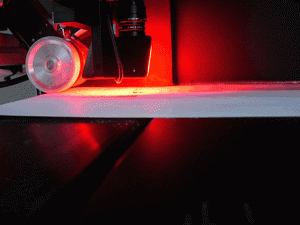Laser Cutting Machine Options
Spartanics is able to customize your laser cutting machine with options that are suited for your specific applications. Please read below to learn about some of the most common add-on features that Spartanics has to offer. If you do not see a particular feature or have questions regarding capabilities for your laser cutting solution, please contact us by filling out our ‘Contact Form’ or call us directly to speak with a specialist -+1 (847)394-5700.
UV COATING SYSTEM |
The varnish station is used to enhance the look of a label and/or increase the durability. Flood coating (complete coverage) or spot coating (specific areas) are possible options for UV coating stations |
ROTARY DIE CUTTING STATION |
The rotary die cutting station offers flexibility for customers that require longer job runs on their digital printing lines or flexo presses. Magnetic dies attach to a rotary cylinder within minutes for quick changeover. The use of rotary die equipment has been a staple in many label, textile and adhesive tape manufacturing operations for years due to overall speed and relative flexibility. A full cylinder rotary die cutter uses a cylinder that holds a die plate for making an impression during each revolution. The problem with shorter runs is there is no flexibility for changing the size of the step and repeat. In order to change the step-and-repeat you need a completely different cylinder which can be expensive. Semi-rotary die cutting cylinders controlled by servo motors are also available. The cylinder and substrate react in tandem to provide a lot of flexibility in terms of part layouts and step ups. A full cylinder rotary die makes for a difficult changeover when removing a full 25” wide cylinder that can weigh 400 lbs. A 25” full rotary die cylinder requires every print job to have the same step and repeat of approximately 23”. A 25” semi-rotary cylinder gives the user the ability to run, for example, a 12” step up therefore providing more reasonable die costs and much more flexibility on shorter run jobs. |
ROTARY SHEETING OPTION |
The rotary sheeting option takes a roll of printed/laser cut labels and converts these labels into sheets. A rotary cylinder is designed with cutting blades across the width of the cylinder to cut the roll of material into sheets each revolution. Most designs require a semi-rotary cylinder that has the flexibility to cut a variety of sheet lengths determined by the job requirement. The sheet can then be placed in a catch bin or a motorized stacker for further processing. |
ROTARY HOT STAMPER |
This option is used to enhance the look of a particular label. A heated platen and pressure are used to press down the foil material onto a given substrate (media) to make the label look more elegant. The foil is positioned above the material and imprinted allowing the combination of heat, dwell time, pressure and stripping time to control the quality of the stamp. An example would be a wine label with an image of rolling hills and a thin foil border to enhance the overall appearance. |
KNIFE SLITTING COMPONENT |
Provides a cheap alternative for slitting with stationary knife blades. These blades are manually positioned using set screws for distance and depth of cut. Slitting is used to take a 350mm wide roll of material that has been printed with multiple jobs and create separate label job rolls. For example, the customer prints two rows of labels and the slitting device cuts through the 350mm wide web to make two 175mm rolls. The separate rolls then rewind on a spindle (or separate spindles) and are removed by the operator. |
ROTARY KNIFE SLITTING COMPONENT |
This option provides a more expensive alternative for slitting using adjustable rotary blades against an anvil for slitting rolls. Rotary slitting blades can be manually positioned using set screws for distance and depth of cut or automatically controlled through the operator interface. Slitting is used to take a 350mm wide roll of material that has been printed with multiple jobs and create separate label job rolls. For example, the customer prints two rows of labels and the slitting device cuts through the 350mm wide web to make two 175mm rolls. The separate rolls then rewind on a spindle (or separate spindles) and are removed by the operator. |
LAMINATION COMPONENT |
Lamination provides a protective coating on the top or bottom of the finished label substrate. This option may enhance the look of a label and also provides more durability than the UV coating option. Single-sided, double-sided (top and bottom) lamination options are available. This component may require multiple rewinds for backer liner removal or it may simply apply a top layer of protection with or without a removing a liner. |
BARCODE READING |
Barcode reading allows automatic changeover. With this option, the machine will be capable of running multiple jobs in one run, change cut configurations on the fly and can provide automatic database integration for total parts traceability. |
XY REGISTRATION |
Spartanics optical print XY registration and camera systems can sense anything by contrast or shape. |





